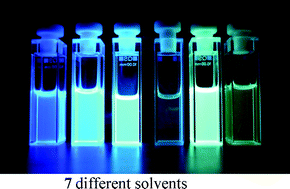A series of diphenylacetylenes with one 1,3,2-benzodiazaborolyl end group (BDB) and a second end group X (X = H, OMe, NMe2, SMe, CN and BDB) were synthesized using established 1,3,2-benzodiazaborole methodologies. The 1,3,2-benzodiazaborolyldiphenylacetylenes with X = p-H (4), p-OMe (5), p-NMe2 (6), p-SMe (7) and p-CN (8) end groups are functionalized with cyano groups at the central ring in an ortho-position to the triple bond. Molecular structures of 2, 3, 5, 6 and 7 were determined by X-ray diffraction. These borylated systems show intense blue luminescence in cyclohexane, toluene, chloroform, dichloromethane and tetrahydrofuran, whereas green luminescence was observed in acetonitrile solutions. Thereby Stokes shifts in the range 1700–8600 cm−1 and quantum yields of 0.60–1.00 were observed in cyclohexane solutions. The absorption maxima (308–380 nm) are well reproduced by TD–DFT computations (B3LYP/G-311G(d,p)) and arise from strong HOMO–LUMO transitions. The LUMOs in all the molecules under study are mainly located on the diphenylacetylene bridge, while with the exception of the dimethylamino derivative 6, the HOMO is largely benzodiazaborolyl in character. Thus, the S1←S0 absorption bands are assigned to π(diazaborolyl)–π*(diphenylacetylene) transitions. In contrast to this, in compound 6 the HOMO is mainly represented by the terminal dimethylaminophenyl unit. While calculated ground state dipole moments μg are small (1.1–7.5 D), experimentally determined changes of the dipole moments upon excitation are large (14.8–19.7 D) and reflect a significant charge transfer upon excitation. NLO activities of the rod-structured compounds 2, 4, 6 and 8 are indicated by calculated static first-order hyperpolarizabilities β up to 76.8 × 10−30 esu.


 Please wait while we load your content...
Please wait while we load your content...